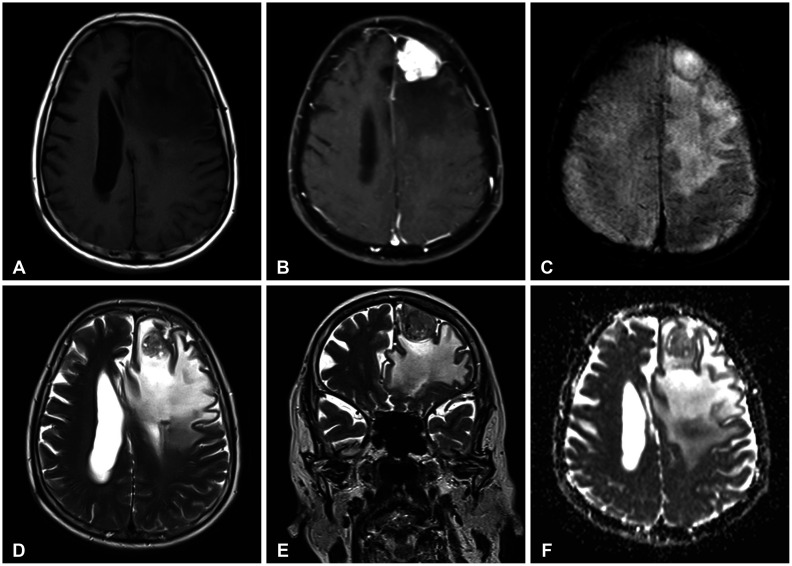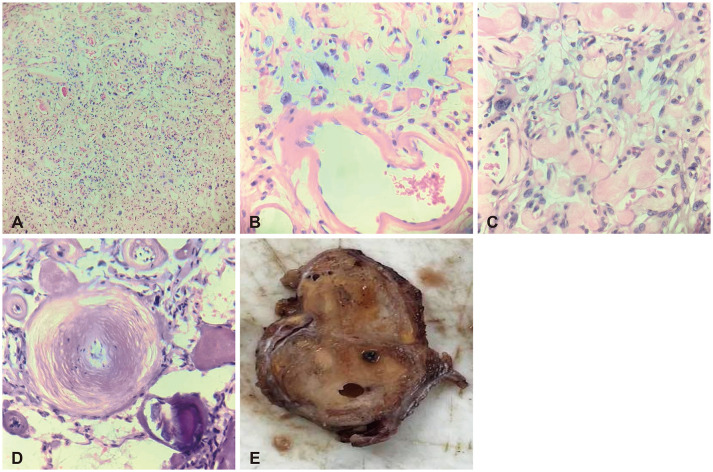Brain Tumor Res Treat.
2023 Apr;11(2):140-144. 10.14791/btrt.2022.0029.
A Meningioma With Extensive Peritumoral Edema Mimicking Metastatic Brain Tumor: A Case Report
- Affiliations
-
- 1Department of Neurosciences, East Avenue Medical Center, Quezon City, Philippines
- 2Department of Pathology, East Avenue Medical Center, Quezon City, Philippines
- 3Department of Neurosurgery, East Avenue Medical Center, Quezon City, Philippines
- KMID: 2542086
- DOI: http://doi.org/10.14791/btrt.2022.0029
Abstract
- Meningioma is the most common brain tumor among all histologically reported malignant and non-malignant tumors of the central nervous system. Angiomatous meningioma is one of the subtypes of meningioma that is rarely reported. In this paper, we present a case of a 67-year-old female patient who sought consultation due to seizure, cognitive decline, and parkinsonism. Contrast-enhanced MRI showed a well-defined tumor in the left frontal lobe convexity with extensive perilesional edema. A tumor excision was done and histopathology studies revealed an angiomatous meningioma subtype. This case is reportable because angiomatous meningioma is a recognized rare entity. It is important to share this entity with other medical professionals and start to consider this condition in differential diagnosis when diagnosing a patient with an intracranial mass with an extensive peritumoral edema. Furthermore, the patient’s unusual presentation of parkinsonian features and its occurrence with colorectal cancer history suggest a possible association between these conditions.
Keyword
Figure
Reference
-
1. Ostrom QT, Patil N, Cioffi G, Waite K, Kruchko C, Barnholtz-Sloan JS. CBTRUS statistical report: primary brain and other central nervous system tumors diagnosed in the United States in 2013-2017. Neuro Oncol. 2020; 22(12 Suppl 2):iv1–iv96. PMID: 33123732.2. Hasselblatt M, Nolte KW, Paulus W. Angiomatous meningioma: a clinicopathologic study of 38 cases. Am J Surg Pathol. 2004; 28:390–393. PMID: 15104303.3. Bansal D, Diwaker P, Gogoi P, Nazir W, Tandon A. Intraparenchymal angiomatous meningioma: a diagnostic dilemma. J Clin Diagn Res. 2015; 9:ED07–ED08.4. Hua L, Luan S, Li H, Zhu H, Tang H, Liu H, et al. Angiomatous meningiomas have a very benign outcome despite frequent peritumoral edema at onset. World Neurosurg. 2017; 108:465–473. PMID: 28844928.5. Louis DN, Perry A, Wesseling P, Brat DJ, Cree IA, Figarella-Branger D, et al. The 2021 WHO classification of tumors of the central nervous system: a summary. Neuro Oncol. 2021; 23:1231–1251. PMID: 34185076.6. Yang L, Ren G, Tang J. Intracranial angiomatous meningioma: a clinicopathological study of 23 cases. Int J Gen Med. 2020; 13:1653–1659. PMID: 33408502.7. Ben Nsir A, Chabaane M, Krifa H, Jeme H, Hattab N. Intracranial angiomatous meningiomas: a 15-year, multicenter study. Clin Neurol Neurosurg. 2016; 149:111–117. PMID: 27513979.8. Liu Z, Wang C, Wang H, Wang Y, Li JY, Liu Y. Clinical characteristics and treatment of angiomatous meningiomas: a report of 27 cases. Int J Clin Exp Pathol. 2013; 6:695–702. PMID: 23573316.9. Hwang J, Kong DS, Seol HJ, Nam DH, Lee JI, Choi JW. Clinical and radiological characteristics of angiomatous meningiomas. Brain Tumor Res Treat. 2016; 4:94–99. PMID: 27867918.10. WHO Classification of Tumours Editorial Board. Central nervous system tumours. 5th ed. Lyon: International Agency for Research on Cancer;2021.11. Bodla AA, Mehta P, Mushtaq F, Durrani OM. Angiomatous meningioma of orbit mimicking as malignant neoplasm: a case report and literature review. Orbit. 2011; 30:183–185. PMID: 21780930.12. Malmer B, Tavelin B, Henriksson R, Grönberg H. Primary brain tumours as second primary: a novel association between meningioma and colorectal cancer. Int J Cancer. 2000; 85:78–81. PMID: 10585587.
- Full Text Links
- Actions
-
Cited
- CITED
-
- Close
- Share
- Similar articles
-
- Failed First Craniotomy and Tumor Removal of Parasagittal Meningioma with Severe Peritumoral Brain Edema
- Meningioma With Partial and Spontaneous Regression of Peritumoral Edema on Long-Term Follow Up
- Radiological Characteristics of Peritumoral Edema in Meningiomas
- Factors Influencing the Development of Peritumoral Brain Edema in Menigiomas
- Crush Cytology of Secretory Meningioma: A Case Report




